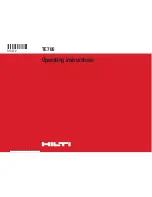
5
Parts & Service: 020 8988 7400 / E-mail: [email protected] or [email protected]
SAFETY RULES FOR OSCILLATING SAWS & SANDERS
1.
Hold power tools by insulated gripping surfaces when performing an operation
where the cutting tools may contact hidden wiring.
Contact with a “live” wire will
make exposed metal parts of the tool “live” and shock the operator. Do not cut or
break into existing walls or other blind areas where electrical wiring may exist. If this
situation is unavoidable, disconnect all fuses or circuit breakers feeding this worksite.
2.
Use a metal detector to determine if there are gas or water pipes hidden in the work
area or call the local utility company for assistance before beginning the operation.
Striking or cutting into a gas line will result in explosion. Water entering an electrical
device may cause electrocution.
3.
Keep hands away from cutting area. Do not reach under the material being cut.
The
proximity of the blade to your hand is hidden from your sight.
4.
Do not use dull or damaged blades.
Bent blades can break easily or cause
kickback.
5.
Exercise caution when handling the accessories.
The accessories are very sharp.
6.
Wear protective gloves when changing cutting accessories.
Accessories become
hot after prolonged usage.
7.
Limit the exposure time to vibration by taking frequent rest periods.
Vibration caused
by the tool may be harmful to the hands and arms.
8.
Before scraping, check the workpiece for nails. If found, either remove them or set
them well below intended finished surface.
Striking a nail with accessory edge could
cause the tool to jump.
9.
Do not wet sand with this tool.
Water entering the motor housing is an electrical
shock hazard.
10.
Never work in area which is wet or damp such as newly applied wallpaper.
There is
an electrical shock hazard when working in such conditions with a power tool and
heating of the water caused by scraping action may cause harmful vapours to be
emitted from workpiece.
11.
Always wear eye protection and a dust mask for dusty applications and when
sanding overhead.
Sanding particles can be absorbed by your eyes and inhaled
easily and may cause health complications.
12.
Use special precautions when sanding chemically pressure treated lumber, lead-
based paint, or any other material that may contain carcinogens.
A suitable
breathing respirator and protective clothing must be worn by persons entering the
work area. The work area should be sealed by plastic sheeting and persons not
protected should be kept out until work area is thoroughly cleaned.
13.
Do not use sandpaper intended for larger sanding pads.
Larger sandpaper will
extend beyond the sanding pad causing snagging, tearing of the paper or kick-
back. Extra paper extending beyond the sanding pad can also cause cuts.
14. Please keep these instructions in a safe place for future reference.
Содержание CMFT300QR
Страница 16: ......


































